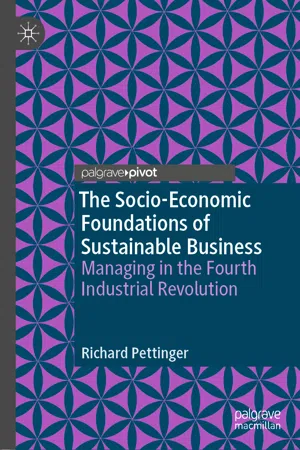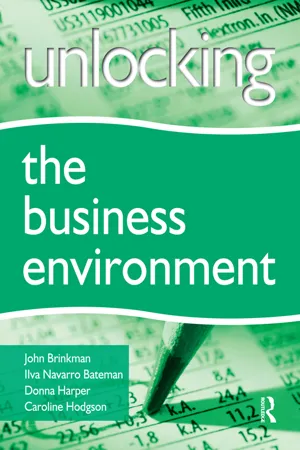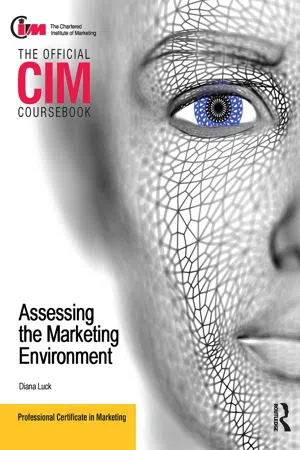Economic Environment
The economic environment refers to the conditions and factors that influence the production, distribution, and consumption of goods and services within an economy. This includes elements such as economic growth, inflation, unemployment, and government policies. Understanding the economic environment is crucial for businesses as it helps them anticipate market trends, assess risks, and make informed decisions.
8 Key excerpts on "Economic Environment"
- eBook - ePub
The Socio-Economic Foundations of Sustainable Business
Managing in the Fourth Industrial Revolution
- Richard Pettinger(Author)
- 2020(Publication Date)
- Palgrave Pivot(Publisher)
...There is also the critical influence that every organisation and its activities has on collective and individual behaviour; and this part of environmental analysis ought to be a key influence on managerial knowledge and expertise. This chapter draws on and develops standard and well known analytical approaches to the organisational and operating environment. It specifically reviews and develops the PESTEL approach to give a much greater emphasis to behavioural, social and technological factors. The Economic Environment The Economic Environment is the core of the context in which all business, managerial and organisational activities take place. Of key concern are the following: the overall structure of the Economic Environment, and the mix of commercial, public service and not for profit activities that are conducted; the potential for growth and opportunities; the volumes and value of business conducted; key macro issues including: money supply; interest and inflation rates; the rates of business growth, both overall and also by sector and location; employment rates and density; and unemployment rates and whether unemployment is structural or transitional; pay, wage and salary rates, and the resultant propensities to spend and save; the frequency, value and volumes of business transactions, both overall and also by sector, location and activity; the structure and quality of the business infrastructure, including: transport; access and egress; telecommunications; physical and technological/virtual connectivity; IT systems and other technology; and commercial and domestic property; availability of skilled staff with required and demanded expertise; ‘market rates’ for specific skills and expertise; specific actions taken by national, regional and local government to develop and ‘pump prime’ activities, by sector, location and activities; other impacts and interventions by national, regional and local government and their agencies (e.g...
- eBook - ePub
- Tom Craig, David Campbell(Authors)
- 2012(Publication Date)
- Routledge(Publisher)
...The macro-Economic Environment includes such national and international concerns as: levels of tax levied by the government; levels of public expenditure (i.e. spending by the state); the price of borrowing money (i.e. interest rates); the rate of growth of the money supply; the size and rate of growth of the economy as a whole; the rate of inflation in the national economy and how this compares to other countries; the value of currency when it is used to exchange for foreign goods and services; the rate of unemployment (i.e. the number of people unemployed compared to the total labour force); the pattern of business and capital transactions that a country carries out with foreign countries (expressed in the balance of payments statement). Changes in the macro-Economic Environment are very important to both businesses and individuals. This is principally because they can affect their income and (in the case of businesses) profitability. Changes in any of the macro-economic indicators (see later) can affect an individual business in either or both of two ways. Let us consider a simple example: an increase is announced in National Insurance (NI) contributions. Individuals must pay more NI contributions from their salaries and will therefore have less money to spend in buying the business’s products. This means, when taken as a whole, that a downward pressure is exerted on business revenues (although it should be noted that, in reality, the relationships between consumer expenditure, NI contributions, taxation, and pension contributions are quite complex). This is an indirect influence on the business from the macro-Economic Environment. Put simply, by having a lower level of disposable income, consumers may delay or cancel plans to make purchases from businesses. The company itself will be required to pay more of its profits (in the form of employer’s contribution) to the Department of Work and Pensions...
- eBook - ePub
- John Brinkman, Ilve Navarro, Donna Harper(Authors)
- 2014(Publication Date)
- Routledge(Publisher)
...Thus, allowing the government of that growing economy to collect money from taxes to pay for various requirements, such as security, health and education for its citizens. A growing economy boosts confidence and optimism for the future among individuals, organisations and the nation. Conversely, the opposite happens if the economy shrinks (at certain levels, over a defined period of time, a shrinking economy is called a recession). Individuals may lose jobs and organisations may find it difficult to trade as individuals have less money to spend. Confidence is low. In essence – the economy can be used as a measure of the standard of living in a country. The Economic Environment of an organisation consists of the macro economy of the country, plus the microEconomic Environment of the organisation. Full coverage of economic theory and principles is neither possible nor the intention of this section. Here, we deal with the economic factors in the macroEconomic Environment that are apt to be of interest to an organisation. In the dynamic and increasingly complex international environment in which businesses need to operate, organisations must understand how these factors affect, or have the potential to affect the achievement of their objectives, so that they can identify and respond to opportunities and threats (current and potential), maximising any opportunities and minimising any threats. This chapter will explain the meaning of the widely used term economy, and discuss the main types used in the world today. It goes on to highlight the influence of the global economy, the role of trading blocks and bodies and those of financial institutions. The national cycles of economies are examined in relation to their effect on unemployment, economic growth, inflation and level of imports. National income is presented as a method of assessing the economy and when comparing years, identifying trends in economic growth...
- eBook - ePub
My Start-Up Plan
The business plan toolkit
- Clare Griffiths, Brad Crescenzo(Authors)
- 2012(Publication Date)
- Harriman House(Publisher)
...7. External Environment The way a country is governed will have a direct effect on your business. For example, a government may want to encourage innovation and growth in particular industries, or it may want to implement certain tax policies. The government will also determine the extent of support provided to aspiring entrepreneurs and established businesses. The work of the government is far-reaching, and its budget allocation on public services can impact on national health and social services provision, as well as the education of the current and future workforce. Which political factors are most likely to change? Which of these will have greatest impact on your business? Do they represent opportunities or threats to you and your business? Political factors such as. . .. . . . . .. . . . . .. . . . . . What can you do to prepare or respond to these potential changing factors? I can. . .. . . . . .. . . . . .. . . . . . The economic climate can impact on business operations and decision-making. Economic factors include changes to taxation, interest rates, international trade agreements, exchange rates, inflation rates and the overall growth of the economy. Changes to taxation can affect the amount of profit a business generates, and interest rates may determine how much a business may wish to borrow or save. International trade agreements can affect which countries a business can trade with, and the exchange rates can influence to what extent a business trades internationally. Shifts in inflation rates and the overall state of the economy will undoubtedly shape the economic wellbeing of a workforce, as well as their pay-related demands. Which economic factors are most likely to change? Which of these will have greatest impact on your business? Do they represent opportunities or threats to you and your business? Economic factors such as. . .. . . . . .. . . . . .. . . . . . What can you do to prepare or respond to these potential changing factors? I can. . .. . . ...
- Diana Luck(Author)
- 2010(Publication Date)
- Routledge(Publisher)
...CHAPTER 6 The Economic and International Environment Learning Outcomes Understand the basic workings of the economy. Evaluate measures of economic activity and limitations of economic indicators. Understand the nature of macroeconomic objectives and the role of government. Assess the likely effects of alternative economic and trade policies. Evaluate economic impacts and implications for marketers. Identify the implications of the international environment. STUDY TIP The Economic Environment is one area where we can all have first-hand experience. You must read the newspapers and listen to what is being broadcasted on television or radio. You must also pay attention to the direct impact of economic events such as changing taxes at budget time, a rising interest rate or an accelerating pay freeze...
- eBook - ePub
- Wim Hulleman, Ad Marijs(Authors)
- 2021(Publication Date)
- Routledge(Publisher)
...Products are replaced at a rapid rate. A product lifecycle of a few months is no longer unusual in industrial markets. Technological advancement is accelerating, as are the associated risks. For those companies that provide their own technological advancements through research and development, this factor is one that belong to the direct business environment. For those companies that rely on other firms for new technological developments, technological advancement is an indirect business environment factor. The macroenvironment belongs to the wider company environment. This environment takes in economic trends, variations in exchange rates and the price of raw materials and demographic developments. While these factors can have a major bearing on a company, individual companies cannot exert any influence on them: they are virtually uncontrollable. Because of the disastrous effects they can have on company results, an economic slump or lowering of the exchange rate of an important export country are the entrepreneur’s nightmare. There is however no way in which an entrepreneur can influence these variables. Consequently, it is important that managers have an idea of the influence macroeconomic variables can exert on returns, costs and profits. They can then more easily assess the competitive position of their own company. 1.2.2 The influence of economic variables on a company’s results Profit and loss account Those aspects of the business environment that fall within the field of economics exercise a considerable influence on the results of companies. This is shown in Figure 1.3. FIGURE 1.3 The influence of general economic variables on business results Many of the variables that are shown in Figure 1.3 are dealt with at length in this book. The illustration aims to show how varied the influence of economic variables is on businesses. In Figure 1.3 the different parts of a profit and loss account have been related to economic variables...
- eBook - ePub
Strategic Marketing
An Introduction
- Tony Proctor(Author)
- 2002(Publication Date)
- Routledge(Publisher)
...The business environment is the setting within which a business operates, formulates policies and makes decisions. It is usual to distinguish between the inter nal and the exter nal environment. The for mer usually comprises the various assets and resources possessed by the organization. That is its workforce, plant and machiner y, know- how, financial resources, etc. The latter refer s to people, institutions and developments, etc. which exer t an external influence on how the organization performs. Of course, with the emergence of strategic alliances and networks such a definition of boundaries does tend to become more blurred. Firms need to know all about the business environment in which they operate. It is essential that they can anticipate the changes that are likely to take place in the marketing environment in the foreseeable future. However, as noted above, it is not simply a matter of adapting to change. Organizations can also exercise their own influence on the environment. Among the ways that this can be achieved is the development and commercialization of new technological ideas. These new technologies then become par t of the business environment and in their turn have an impact upon what other organizations can do. Considerable control can be exercised over its internal environment by a firm, but a firm cannot exert control in the same way or to the same extent over the external environment. It can only attempt to influence it. There are various ways of influencing events in the external environment. These may include activities such as lobbying among leg islative g roups...
- eBook - ePub
- Rob Dransfield(Author)
- 2013(Publication Date)
- Routledge(Publisher)
...6 Business strategy in an economic context Chapter Outline 6.1 Introduction 6.2 What business strategy involves 6.3 The ingredients of strategy 6.4 The criteria for an effective strategy 6.5 How an environmental analysis helps to determine the suitability of a strategy 6.6 The nature of strategic vision, objectives, focus and architecture 6.7 Business strategy in an economic context 6.8 Summary Chapter Objectives By the end of this chapter you will understand : Why businesses need to have an effective strategy The components that need to be in place to create a business strategy How to judge a strategy in terms of suitability, acceptability and feasibility How to create a PEST analysis Why it is important to evaluate the Economic Environment and its impact on business strategy 6.1 Introduction Businesses need to have a sense of the direction in which they want to move. Once they are clear about this they can formulate their plans – strategies to achieve their desired goals. However, the process is not as simple as it sounds. Businesses operate in uncertain environments. They need therefore to be continually prepared to adjust their strategies to accommodate for environmental change. Perhaps the biggest uncertainty in the business environment is economic change. This is one of the reasons why an understanding of economics is so important to business students. You need to be able to understand the impact of major macro-economic changes such as changes in the gross domestic product (GDP) of a country, and the relative growth of different economies. This chapter therefore explores corporate strategy in the context of an uncertain Economic Environment...







